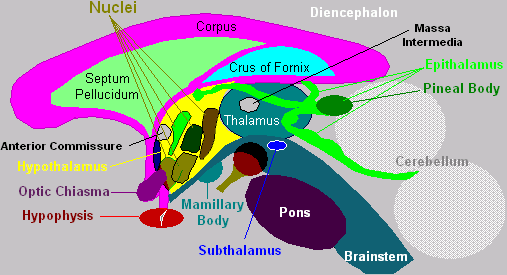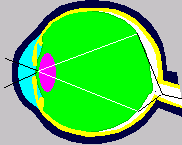02 Jul Centers of Attention and Consciousness
 Can software be conscious? I remember when PC software began to appear that would keep listening after you closed the main program (TSR or Terminate but Stay Resident). Most of those functions migrated to Operating Systems. Operating Systems have grown to occupy a huge footprint on the computer and perform a vast array of functions. Might it be said that the Operating System is analogous to the part of the brain responsible for consciousness and attention? Now we have pocket devices that track us in time and space. Time and space are two of the most essential elements of context, and by tracking context (paying attention or being conscious of where we are in time and space), apps can help us remain informed about what’s around us and help us get what we need and find places where we want to go. How intelligent is that?! I will talk about parts of the brain and their functions today, but before the end of the post, I will discuss the implications for smarter computer programs: programs that use more context than time and space to deliver enormous value to their users.
Can software be conscious? I remember when PC software began to appear that would keep listening after you closed the main program (TSR or Terminate but Stay Resident). Most of those functions migrated to Operating Systems. Operating Systems have grown to occupy a huge footprint on the computer and perform a vast array of functions. Might it be said that the Operating System is analogous to the part of the brain responsible for consciousness and attention? Now we have pocket devices that track us in time and space. Time and space are two of the most essential elements of context, and by tracking context (paying attention or being conscious of where we are in time and space), apps can help us remain informed about what’s around us and help us get what we need and find places where we want to go. How intelligent is that?! I will talk about parts of the brain and their functions today, but before the end of the post, I will discuss the implications for smarter computer programs: programs that use more context than time and space to deliver enormous value to their users.
| Understanding Context Cross-Reference |
|---|
| Click on these Links to other posts and glossary/bibliography references |
|
|
|
| Prior Post | Next Post |
| Gamification – The Future | Motor Center Structure |
| Definitions | References |
| conscious context | Anderson 1983 |
| intelligent attention | Anderson 1988 |
| diencephalon | Williams 1975 |
The Diencephalon
Let’s start by looking into parts of the brain that play significant roles in attention and consciousness. The diencephalon is located at the anterior (front) end of the brainstem surrounded by the cerebrum. It consists of the thalamus, hypothalamus, subthalamus, epithalamus, and geniculate bodies.
The thalamus is the brain’s major sensory integration center. It receives impulses from all the sensory receptors except the olfactory. The thalamus is centrally located, between the central nervous system where thinking is done and the autonomic nervous system where the body is controlled. It thus enjoys an ideal strategic location for coordinating thought and action. Even simple actions, such as rinsing dishes, require the integration of large amounts of common-sense knowledge.
The primary functions of the thalamus appear to be the regulation of attention and the state of consciousness. Emotional responses to sensory stimuli may also originate in the thalamus. The functions of the thalamus are supported by a complex arrangement or circuit of neural connections. The neurons in the thalamus have extensive range. Some receive axon termini from each of the sensory systems, providing direct and immediate activation whenever the senses are stimulated.
Parts of the Diencephalon
A nucleus is a conglomeration of cells that serve a specific function. Several nuclei are shown above in the hypothalamus. Many other brain components are subdivided into specialized nuclei. This further demonstrates the specialization of brain components.
The geniculate bodies in the diencephalon serve as relays: they connect the optical tracts with the visual cortex and the midbrain auditory systems with the temporal lobe of the cerebrum. The hypothalamus, though small, has an extremely complex arrangement of neurons and links. With its direct and indirect links throughout the nervous system, the hypothalamus functions as a regulator for heart rate, body temperature, fluid balance, and glandular secretion. Through its connections to the autonomic nervous system, the hypothalamus is a major center of emotional expression. It is thought that the subthalamus influences sexual functions.
The diencephalon is a complex and specialized processing center. Its morphology includes functional areas containing specialized nerve cells with intricate, highly discriminatory connection schemes. Its connections with the hippocampus and amygdala play key roles in regulating hormonal activity associated with emotions.
Specialization and complexity occur in all areas of the brain. Let’s delve into the form and circuitry of the cerebellum for clues to modeling cognition. The functions of the thalamus are integration, correlation and relay. From the associationist standpoint, these are some of the most important components of human cognition. The thalamus enables us to focus attention, consciously perceive input, and interpret pain.
Coordinating Roles
The thalamus, hypothalamus, and geniculate bodies coordinate activities within and outside of the central nervous system. Considering the specialization of the areas described, coordination of divergent roles must be extremely important to insure that complementary functions act in concert. The effects of congenital defects, disease, and other damage to the brain punctuate the importance of such coordination. When a coordinating area is dysfunctional, one or more physical functions are often impaired or inoperative.
Naturally, the body needs to act as a whole. While some activities dominate mental processing at certain times, and others seem dormant, the brain must coordinate all activities all the time. To orchestrate this coordination, the nervous system is organized with complementary specialized areas distributed into different parts of the body. Voluntary motor control and processing are done in the somatosensory cortex and the cerebellum. Involuntary and life support functions are processed in the midbrain. Execution (determining the actual processes of movement) is processed in the cerebellum.
Cybernetic Implications
Before proceeding with the macroscopic structure of the brain, consider the structural and functional implications on computer modeling of cognitive functions:
- The brain has different regions for different roles.
- Brain regions have unique structural characteristics that facilitate their respective roles.
- Cells within brain regions have unique organizations of cells that facilitate their respective roles.
This combination of heterogeneity and specialization may help in the development of models for more brain-like computers. A computer may, for example, be compared to a brain, and its components to regions of the brain. Because of the complexity of the processes performed in various regions of the brain (remembering, recognizing, interpreting…), a computer may also be compared to a region of the brain and a network of computers to the whole brain. We will revisit this idea in future posts.
| Click below to look in each Understanding Context section |
|---|











